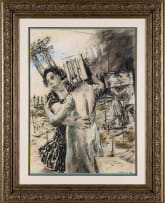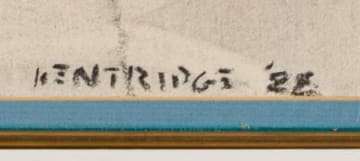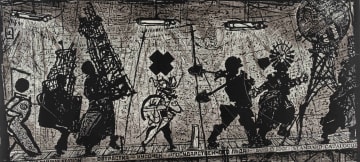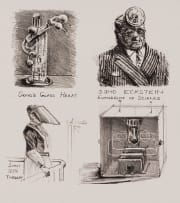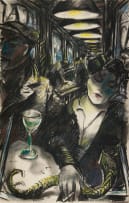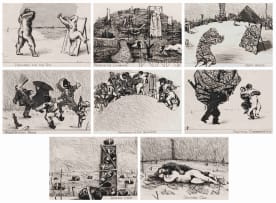The Highveld Style Masked Ball
William Kentridge
Incl. Buyer's Premium & VAT
About this Item
signed and dated '88
Notes
William Kentridge's activities encompass a great many expressive forms, including sculpture, mural, film, theatre, opera, procession and fantastical public spectacles that merge all these discrete media. However, drawing, the activity that informs this important early work from a period of artistic self-discovery, has always been his primary means of expression. 'It is only when physically engaged on a drawing that ideas start to emerge,' said Kentridge in 1993. 'There is a combination between drawing and seeing, between making and assessing, that provokes a part of my mind that otherwise is closed off.'1 In 1999 he described drawing as 'a testing of ideas; a slow-motion version of thought. It does not arrive instantly like a photograph.'2
Kentridge began drawing at an early age. 'My mother's story is that I was drawing from when I was three,' said Kentridge in 2009.3 He began attending children's art lessons at age eight. During his adolescence he studied under artist Bill Ainslie, his rigorous academic programme and expressionist enthusiasms exerting a considerable influence on a young Kentridge. 'That was a transition of style, of thinking.'4
Kentridge's debut solo exhibition at the Market Gallery in 1979 included some of his drawings. However, he shortly stopped making art and closed his studio. 'It was a critical time of assessing what it is I do well, or at least how a few of the different things I do well could find a place.'5
In 1984, at the prompting of dealer Reinhold Cassirer, a family friend, Kentridge began drawing again. His principal medium was charcoal. His first exhibition at Cassirer Fine Art a year later included a number of mixed-media drawings (charcoal with pastel, crayon and/or gouache) in the manner of this lot. The subject of Kentridge's darkly existential and occasionally surreal compositions depicting figures in congested drawing rooms, cafes and opera houses was South Africa's white haute bourgeoisie. The excoriating tone of these claustrophobic interior compositions, works uniformly marked by their noirish tonality and compressed perspective, recalled the social critique of Nadine Gordimer's 1966 novel, The Late Bourgeois World, but also manifested the artist's tendency towards satire. Kentridge, an admirer of Honoré Daumier, was briefly the cartoonist for the leftist Weekly Mail in 1985.
Following his breakthrough drawings of the mid-1980s, Kentridge began producing drawings and prints informed by the 'post-industrial wilderness' of Johannesburg.6 'I started calling myself an artist in my thirties when I discovered not just the necessity but the pleasure
of drawing the landscape just to the south of Johannesburg … And also when I discovered the pleasure of a soft chamois leather dipped into charcoal dust and wiped across the white surface of the paper, leaving not just a train of dark charcoal grit on the paper but also of a darkening sky above a light horizon.'7
The present lot is an important work that combines the twin features of figuration and landscape that strongly characterise Kentridge's revolutionary early drawings from the 1980s. The styling of his figures, with their strange head adornments of cutlery and pylons, dancing on a highveld landscape is consistent with Kentridge's well-known poster triptych Art in a State of Grace, Hope and Siege (1988) and the work Untitled Drawing Towards Responsible Hedonism (1988), both of which deploy similar iconography. Strauss & Co sold the latter drawing for R3 978 800 in June 2017.
While 'drama, denunciation and melancholy' are the chief themes of these drawings as a group, they are also characterised, writes art historian Carolyn Christov-Bakargiev, 'by humour and irony, as well as by the numerous references to pleasure and desire that characterise all of Kentridge's art … A simultaneity of contradictory and unreconcilable [sic] points of view is presented both literally (only in the surreal world of dreams could these absurd scenes occur) and metaphorically (the artist is evoking the deranged, conflicting aspects of South African society under apartheid).'8
These conflicts encompassed South Africa's Jewish community, of which Kentridge, born of Lithuanian and German-Jewish ancestors, is a part. This drawing was commissioned by the newly formed Imanu-Shalom congregation for a masked ball to raise funds for various charities. Formed in 1986, Imanu-Shalom was a progressive Jewish congregation with two temples. The congregation controversially invited ANC leader Nelson Mandela to address its members shortly after his release from prison in 1990.
It bears noting that Kentridge's early drawings did not immediately arouse international interest. 'When I first went to New York with my portfolio in 1986, I thought the big problem would be being a white South African. But the least important problem was that I was a white South African coming from an apartheid South Africa. The biggest problem was that I made drawings and not paintings.'9 Key early drawings by Kentridge now routinely command six figure sums at local and international auctions.
- William Kentridge (1993) Fortuna: Neither Programme nor Chance in the Making of Images, lecture republished in Carolyn Christov-Bakargiev (1998) William Kentridge, Brussels: Palais des Beaux Arts, page 68.
- William Kentridge (1999) William Kentridge, London: Phaidon, page 8.
- William Kentridge (2009) 'Double Lines', in William Kentridge: Five Themes, San Francisco: San Francisco Museum of Modern Art, page 251.
- William Kentridge (2005) Interview with Sean O'Toole, Houghton, Johannesburg, 5 July.
- William Kentridge (2009) 'Double Lines', op.cit, page 245.
- William Kentridge (2020) 'Finding the Dapple', in William Kentridge and Aimee Ng, Constable's White Horse, New York: The Frick Collection, pages 11-23.
- William Kentridge and Jane Taylor (2018) That Which We Do Not Remember, Sydney: Naomi Milgrom Foundation, page 102.
- Carolyn Christov-Bakargiev (2003) William Kentridge, Milan: Skira, page 64.
- William Kentridge (2013) 'On the Aesthetic and Political Language of Art: A Conversation between Kendell Geers and William Kentridge moderated by Okwui Enwezor,' in Clive Kellner (ed), Kendell Geers 1988-2012, Munich: Prestel, page 103.
Provenance
Stephan Welz & Co/Sotheby's, Johannesburg, Session 2, 20 April 2009, lot 329.


